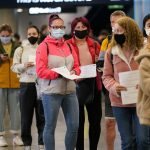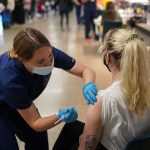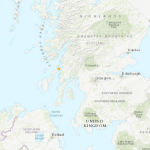Britons were treated to “the best light show on Earth” on Wednesday night as a solar storm and clear skies resulted in a stunning display of the Northern Lights across the country.
Nature’s dazzling light display is a consequence of solar activity – collisions of charged particles in the solar wind colliding with molecules in the Earth’s upper atmosphere.
Also known as Aurora Borealis, the Northern Lights are usually visible in high-latitude regions closer to the Arctic such as Scandinavia and typically appear as curtains, rays, spirals or dynamic flickers covering the entire sky in pale green, pink, shades of red, yellow, blue and violet hues.
But stargazers across the UK were treated to a captivating display overnight.
Many captured pictures of the vivid green, red and other coloured lights streaking through the night sky – with people living in Scotland to as far south as Devon sharing them on social media.
One Twitter user from Cumbria tweeted some photos of the display, writing: “Love where I live, soon joined by most of the village all standing in awe at the best light show on earth! Awesome to share together!”
More #aurora from the #edenvalley #cumbria tonight. Love where I live, soon joined by most of the village all standing in awe at the best light show on earth! Awesome to share together! #NorthernLights pic.twitter.com/nwNG0209IE
21:30 3rd Nov 2021 #Aurora Nice fast flare arrived 🙂 #isleoflewis #Ness #Hebrides #Milkyway @chunder10
@stormHour @TamithaSkov @VirtualAstro @Aurora_Alerts @aurorawatchuk pic.twitter.com/MTZuMyEZWm
Well that is unexpected (hence the poor quality pic)! An Aurora show from the house right now!!! #Aurora #NorthernLights #Scotland @StormHour @ThePhotoHour pic.twitter.com/i6EUyryNs5
Another said: “Well that is unexpected (hence the poor quality pic)! An Aurora show from the house right now!!!”
Climate change: ‘Walrus from Space’ project urges public to help search for animals in satellite images
Yevgeny Zinichev: Russian emergencies minister dies during Arctic training drill
Expedition crew believe they’ve accidentally discovered world’s northernmost island
Others braved the cold outdoors to get a good view of the display, with one Twitter user writing: “Watching the Aurora Borealis with some of our fellow villagers tonight. Above Croglin, Cumbria.”
Watching the Aurora Borealis with some of our fellow villagers tonight. Above Croglin, Cumbria. Thank you to the awesome @kathelcymru for both the alert and taking this photo! #northernlights pic.twitter.com/J92ivVj9Gf
It was a bit cloudy tonight, but there was good aurora display again near Dornoch, Sutherland, UK. #auroraborealis #NorthernLights pic.twitter.com/QIbMLbJrzq
Well that was rather special 😍😍😍#NorthernLights #TheMirrieDancers #Shetland pic.twitter.com/BZzV9rF277
“The Northern Lights were visible over Devon this evening – this was taken at about 2100 near Crediton,” wrote another.
The Met Office predicted the visibility of the northern lights this week, due to a geomagnetic storm.
There have been more geomagnetic storms this autumn than normal, with Britons also enjoying vivid light displays on Halloween last week.
The flare – officially known as a coronal mass ejection (CME) – left the sun last Thursday and arrived as Earth entered a period of increased solar activity.
Light show outside my house this evening 😊 #NorthernLights pic.twitter.com/3mBoyqEtaV
More #aurora joy from the back door tonight ✨#nafirchlis #merrydancers #northernlights #scotland #highlands #inverness pic.twitter.com/nE7fsCDlph
The CME “was much slower and weaker than expected”, the Met Office said, despite being an X1-class flare – the strongest there is.
Solar activity has been observed rising and falling naturally every 11 years or so, with astronomers believing we are now in the early years of a new busy period.
A new family of sunspots, discovered on the side of the sun facing Earth last year, unleashed the biggest solar flare scientists had seen since 2017.






















